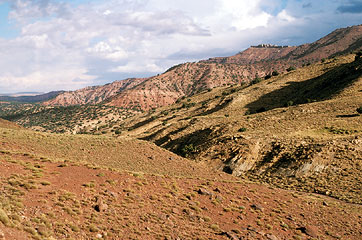 |
|
|
|
|
|
|
The Giant and Central Atlas as well as the southern front ranges (Sahara and Anti-Atlas) are in a transition zone between the Mediterranean and the Saharan (subtropical) climate. The alpine belt above the juniper treeline in the central parts is dominated by tussock grasses and hemisphere-shaped shrubs, largely belonging to Asteraceae and Euphorbiaceae. Winters are cold and snow is common, but summers are long and very dry, hence the vegetation is commonly very sparse. A forest cover is missing in the southern ranges (too dry), hence the alpine belt is poorly defined. |
|
1 - The Central Atlas landscape (> 2300 m). |
|
|
2 - The Central Atlas landscape (> 2300 m). |
3 - Typical halfa grass high elevation steppe at 1400-1800 m elevation, below of what would be alpine in terms of climate. |
4 - Stipa tenesissima (Poaceae), "halfa", the most prominent tussock grass (compare the similar vegetation on Mexican volcanoes). |
|
5 - "Hedgehog" shape cushion plants (Helichrysum sp., see Mt. Kilimanjaro and Australia). |
6 - Thorny cushions - a response to millenia of pastoralism (Asteraceae). |
29 August 2011 |
||
| |
||






